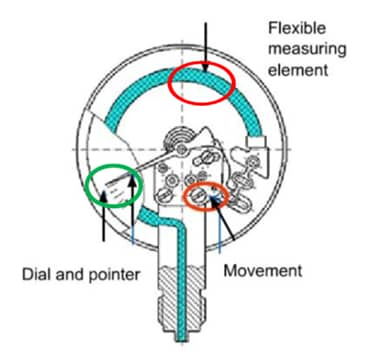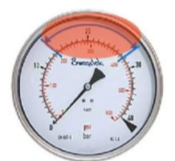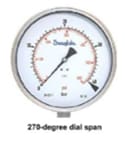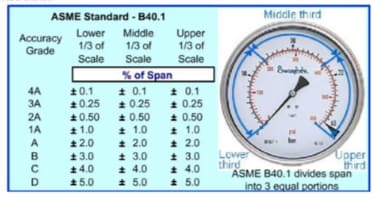Understanding Pressure Gauges

To select proper gauges for your system, it is important to understand how pressure gauges work and the options available to you. Read on to learn about the 3 functional components in a typical pressure gauge, what the dials of typical gauges show and how to identify accuracy standards of your pressure gauges.
The first functional component of a pressure gauge is the flexible measuring element. Bourdon tube and diaphragm flexible measuring elements are the two most common used today.

By contrast, a diaphragm measuring element is found in gauges that measure lower pressures (less than 400 mbar or 15 psi). When exposed to pressure, the diaphragm element becomes deformed and creates rotary movement of the pointer at the end of the dial.
The second functional element of a pressure gauge is the movement. This consists of a gear and a lever. The flexion of the measuring element (described above) translates through the movement and causes rotation of the pointer through the gear and lever.
Gauge dials have scales that typically span a 270 degree arc. The pointer, which moves using the elements described above, indicates the amount of pressure registered on the dial.
On the dial of a pressure gauge, you will find:
- The span or dial arc
- Units of pressure the gauge works in
- The accuracy class of the gauge
- The safety marking
You will also consider the following when selecting proper gauges:
- The case is designed to accommodate different connection options, including lower mount, center back mount and lower back mount positions.
- Liquid-filled gauges dampen the forces of shock and vibration. This makes the gauge easier to read when those conditions are present. Liquid filling also reduces the potential for corrosion inside the gauge and acts as a lubricant and coolant for the gauge's moving parts.
About Accuracy Standards:

To protect the gauge AND ensure accuracy, the full scale range of the pressure gauge should be twice the system's working pressure, so that typical operating readings appear in the mid-third of the scale range.
In static applications, system working pressure should be ¾ or less of the scale range. In dynamic applications where there may be pressure spikes or surges the system working pressure should be 2/3 or less of the scale range.
Consider the level of accuracy required when selecting a gauge for your system. A gauge with a standard of plus or minus one percent means that it will provide a measure of pressure within one percent of the true pressure.
In the United States, ASME B40.1 assigns grades to convey the accuracy standards of different gauges.
Additional criteria to consider when selecting your gauges include:
- Your process media
- Ambient temperature
- Pressure range
- Dial size
- The amount of vibration and shock potential from the system
- Mounting and end connection requirements
Swagelok offers gauges that meet ASML B40. 1 accuracy requirements and come in a variety of sizes and end connection types, including Swagelok tube adapters. Stainless steel construction and wetted parts are compatible for corrosive service. For additional reliability, you may also select Swagelok factory-calibrated and pressure tested gauges.
Safe Product Selection
The complete catalog contents must be reviewed to ensure that the system designer and user make a safe product selection. When selecting products, the total system design must be considered to ensure safe, trouble-free performance. Function, material compatibility, adequate ratings, proper installation, operation, and maintenance are the responsibilities of the system designer and user.


